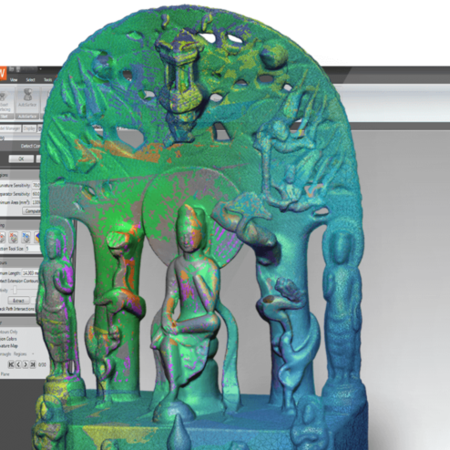To most people, a container is just something that holds a product. But for Uniloy Milacron customers, the container is an integral part of what defines a brand.
The services are provided by GKS Inspection Services, a division of Laser Design Inc. GKS uses its Laser Design scanners to capture the geometry of the plastic containers, and Geomagic Wrap software to process scan data into accurate 3D surface models for downstream CAD and machining.
“This new process has many benefits,” says Jim Janeczek, product design engineer for Uniloy Milacron’s facility in Tecumseh, Michigan. “It has enabled us to produce more accurate molds, free up machine time for CNC systems we use in milling, and drastically cut the time it takes us to develop a new mold.”
Replicating a Complex Shape.
A recent project is typical of the work process between Uniloy Milacron and GKS, based in Plymouth, Michigan. In this case, Uniloy Milacron presented GKS with a two-liter plastic milk bottle to duplicate. Although it might look like a basic container when resting in our refrigerator, a typical milk bottle is fairly complex and difficult to replicate using CAD programs.
“We use Pro/ENGINEER to design new containers from scratch,” says Janeczek, “but we needed to apply different technology to duplicate our customers’ designs.”
The ability to quickly capture and model existing physical objects containing free-form shapes defines the difference between CAD and reverse engineering using Geomagic: As a drawing-based technology, CAD starts with a blank screen, requiring that the user input dimensions, shapes, curves and surfaces that will define an object. It is great for modeling new products but is limited when faced with describing or representing the complexity of the existing world, especially free-form shapes such as those found in plastic milk containers with molded handles.
Reverse engineering starts with a physical object such as an existing product or prototype. High-speed scanners capture the shape of the object and the resulting point cloud data is fed into software such as Geomagic Wrap. The features of this software are the critical components to success at this point: The software used needs to accurately and rapidly extract geometry and topology from measurement data and create high-quality digital models that can be used by any CAD/CAM/CAE application for downstream functions such as engineering analysis, simulation, and machining.
“Geomagic provides the simplest, fastest and most accurate way to digitally duplicate a part,” says Han Le, the GKS engineer who headed up the Uniloy Milacron project. “You can model the part without taking physical dimensions, and get a CAD model with accuracy within +/- 0.0025 mm (+/-0.0001 inches).”
Millions of Points in Minutes
Le used a Laser Design DS 3040 scanner to capture the two-liter milk bottle. Although the DS 3040 offers the option of using a contact probe for CMM, the clear choice for this project was faster, non-contact scanning.
“With a regular CMM system you wouldn’t be able to get results that are as accurate as those from the DS 3040,” says Le. “You’d have to use a touch probe, and how many times can you touch the part to get accurate dimensions? Plus, for a soft, flexible part, you wouldn’t get accurate data because the probe would change the physical shape of the part.”
A major advantage of the Laser Design system, according to Le, is the ability to scan the container from all orientations using a rotary platform, then easily integrate the data into a common coordinate system.
It took about an hour to scan the milk container, resulting in a point cloud containing approximately two million points. This compares to 24 hours that it used to take Uniloy Milacron to capture a container with a CNC system hooked up to a digitizing attachment. The CNC digitizer captured thousands of points, compared to the millions collected by the Laser Design scanner in a fraction of the time. In addition to providing greater accuracy in less time, the new process helps with workflow and scheduling according to Uniloy’s Janeczek.
“When we were doing this in-house, we needed to vie for time on the CNC machine, which is a vital tool for our milling operation,” says Janeczek. “With GKS providing the scanning and data processing, the CNC machine can be dedicated full-time to milling tasks, and we don’t have to worry about scheduling time to use it.”
The Points-to-Surfaces Transformation
After the points are captured by the Laser Design scanner, they are brought into Geomagic, which provides automated tools for registering scans, decimating dense data sets while maintaining accuracy, correcting scanner errors, and filling holes.
The completed point-cloud model is converted into a polygon model using patented wrap triangulation algorithms provided by Geomagic. Functionality is provided to quickly and easily create a clean polygon model, with the software automating such tasks as creating geometry for areas not captured by the scan, optimizing polygon density, fixing overlapping intersections, and editing polygon attributes.
The final step is to create the NURBS surface model that can be used directly within a CAD system. When advanced control is not necessary, Geomagic can complete this step with one click of a mouse. In the case of the two-liter bottle, Han Le wanted to finely tune certain regions requiring greater detail. For this work, he used features for patch optimization, adaptive surface fitting, and contour detection and extension that were added to Geomagic in version 8, released in summer 2005.
